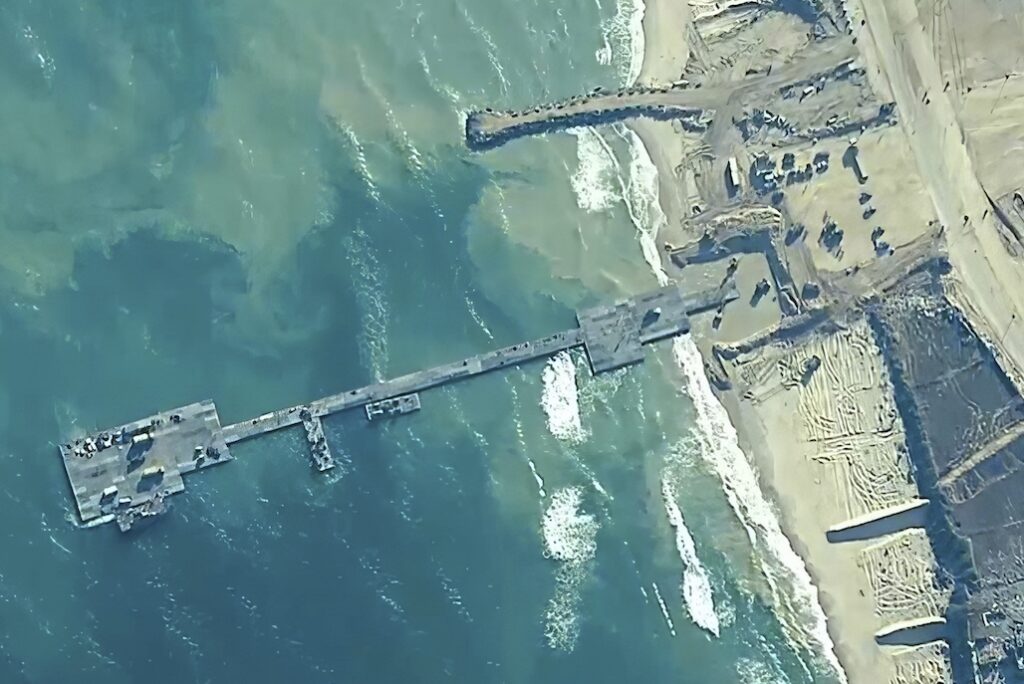
The United States-constructed pier off Gaza’s coast designed to supplement the international efforts to get humanitarian aid into the enclave will be operational again in the near future.
U.S. Central Command built the pier, which was first operational on May 17, only for it to get damaged during inclement weather less than two weeks later. Defense officials argue that the first week or so of the pier’s aid delivery was a success, despite the damage that forced the aid route to be halted for repairs.
“I’m very pleased to announce that earlier this morning, in Gaza, U.S. forces successfully attached the temporary pier to the Gaza beach. Israeli Defense Force engineers provided all the necessary support to ensure the safe emplacement of the pier to the beach,” Vice Adm. Brad Cooper told reporters on Friday. “The policy of no U.S. boots on the ground does remain in effect. We expect to resume delivery of humanitarian assistance from the sea in the coming days.”

Even though it was only operational for about a week, the pier helped deliver roughly 1,000 metric tons, more than 2 million pounds, of aid into Gaza before breaking apart. Cooper said they anticipate roughly 500,000 pounds of aid getting in via the pier daily initially, though they will ramp that up eventually.
The aid meant for Gaza is screened in Cyprus before being put on ships, where it transits the Mediterranean Sea. The vessels stop at the pier, which is floating in the sea far from Gaza’s coast. The aid is offloaded and put on smaller vessels that can get closer to the coast due to the shallower waters. The smaller ships traveling with the aid to the causeway, which is anchored into the beach. The aid is offloaded there and driven by truck down the causeway where it’s offloaded before being placed on trucks for distribution into Gaza.
President Joe Biden announced during his State of the Union address that the U.S. military built this pier as a way to get additional aid into Gaza given the difficulties posed at other access points. U.S. officials have repeatedly said the pier is not meant to replace the other ways of getting aid to Gaza, rather it is an additive method.
The Pentagon initially estimated the pier project would cost roughly $320 million. Even with the damage and subsequent repairs, Pentagon deputy spokeswoman Sabrina Singh told reporters earlier this week that its new evaluation indicates it will be much cheaper than anticipated.
She attributed the smaller estimate to “lower-than-expected costs for contracted trucks, drivers, and commercial vessels, and the United Kingdom’s contribution of a berthing vessel for our soldiers and sailors have lowered our cost,” and noted, “This estimate does include some of the costs associated with the repairs and rebuilding of the pier.”
CLICK HERE TO READ MORE FROM THE WASHINGTON EXAMINER
All of Gaza’s 2.2 million residents are facing acute food insecurity, according to Sonali Korde, assistant to the administrator of USAID’s Bureau for Humanitarian Assistance.
While the pier gets aid to Gaza’s coasts, it’s up to the United Nations and other non-profits to distribute the aid within the strip though that also presents hurdles given the complexities of the battlefield space as well as the desperation of Palestinian civilians in need of assistance.
Scroll down to leave a comment:
[Fancy_Facebook_Comments]







